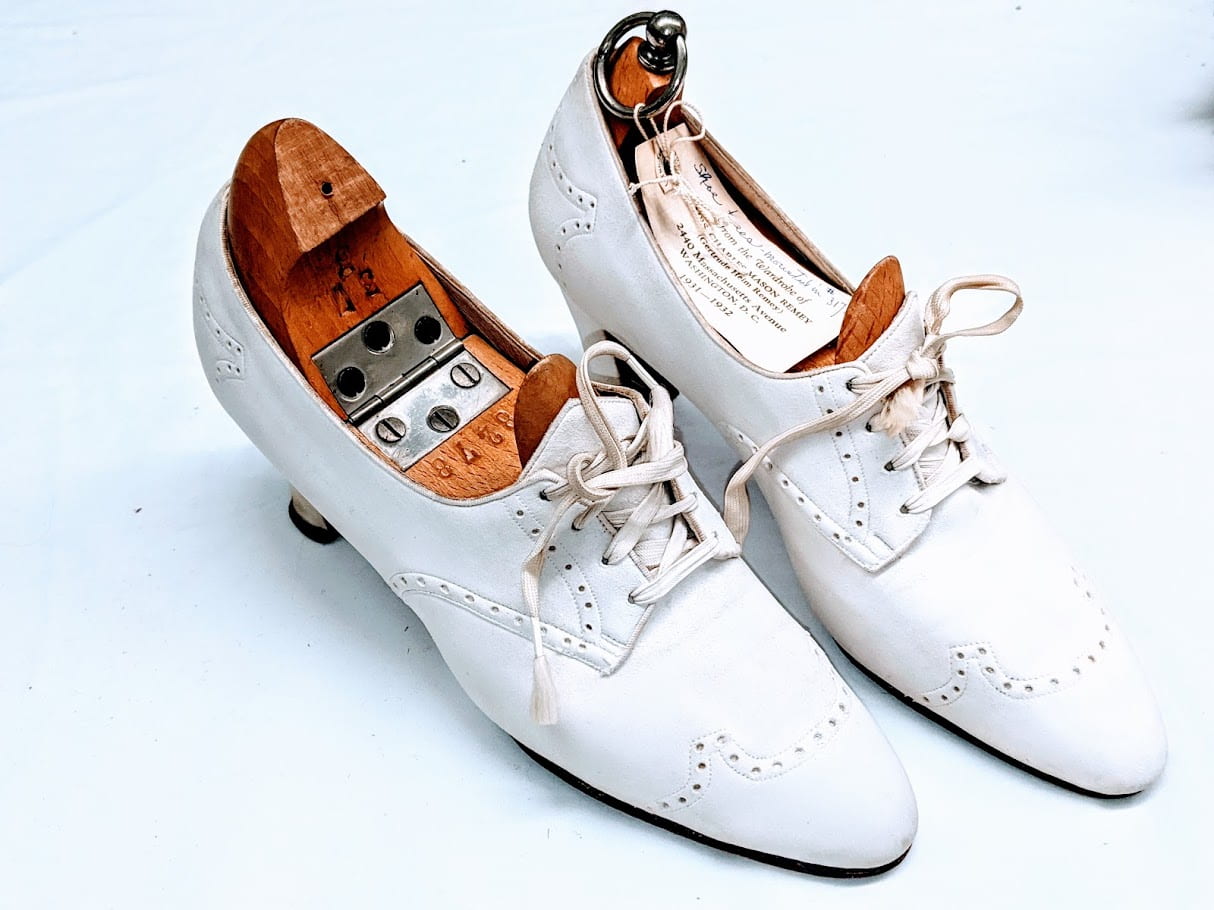Blog post by Diana Corzine ’22.
The loafer, oxford, and heel are classic shoe styles that share another characteristic: they are often worn in professional settings. In the workplace, men may have the option to don relaxed versions of oxfords and loafers, which are wide-set and have little to no heel. Women also have their own version of oxfords and loafers for the workplace—along with a third option, the heel—which presents one stark difference between men’s and women’s business shoes: comfort in wear.

Oxford heels with white suede eyelet details. Purchased in the early 1930s at Garfinckel’s, which was a luxury department store in Washington, DC. Cornell Fashion + Textile Collection, #3178. Photo by Diana H. Corzine.
Throughout history and across cultures, women’s feet have been burdened by uncomfortable shoes. From Japanese Okobo sandals to Middle Eastern kabkabs, Italian, Renaissance-era Chopines to 2007’s debut of heelless shoes, and many more, women’s feet have suffered. Whether through binding, straps, arches, pointed tips, high-heels, or even the lack of heel, a plethora of design elements are present that may “make the shoe” but break the foot…which leads me to ask: why? Why do women hold the record for the most painful shoes? Looking around the Cornell Fashion+Textile Collection, one is met with an array of historical shoes featuring heels; pictured are Gertrude Heim Remey’s suede oxfords from the early 1930s. It must be noted, that yes, men too have undertaken their fair share of painful shoes: King Louis XIV sported red bottom high-heeled shoes to pair with his breaches during his reign of 72 years from 1643 through 1715, in an attempt to raise his height to visually parallel his power. Thus, perhaps, women, like men used to, only take the opportunity of extra height at the expense of their soles. If only:
After World War II, women’s shoes saw a shift, as they became a mode for accentuating the curves and arch of a woman’s foot. Shoes were evolving with the fashion landscape that they were slowly becoming a part of. In the last few decades of the 20th century, as women became more active in workplaces and offices, their shoes…evolved to reflect that — heels and wedges were more popular for this reason in the 1970s, while Oxfords and Loafers remained popular as men’s shoes. (Hefnawy)
If additional height, as with Louis XIV, means power, then the fashion industry produces and promotes uncomfortable heels to both enable and limit the playing field for power. I think of it as a systematic paradox meant to control women’s influence in the workplace, in various industries, and in the world. Women wear heels to gain height and a boost of a confidence. Yet, a couple of hours in—or perhaps, minutes if the shoes are terribly constructed as is the case with most fast-fashion items nowadays—that same confidence becomes hindered by the overwhelming aches and pains that the shoes produce: blisters and sore spots on the feet, and the risk of a sprained ankle. In an endless loop, women participate in wearing an item that increases their self-esteem only to then decrease it. Men surely wore heels for a limited time in the past. Today, go into the nearest office, and you’re not likely to see a male employee donning the same classic, pointy-toed pumps as their fellow female co-worker. I must note, this is not to say women do not participate in wearing oxfords and loafers and that men do not wear heels—I will always root for a man to model heels. However, oxfords and loafers for women typically have heels and embellishments. These might include industry standards of tapered tips or leather cutouts that dig into your skin, which make the shoes ultimately more uncomfortable than the version worn by male counterparts. Take for example the pair of Gucci pictured below: the designer shoes include a gold embellishment motif on the heels themselves! They were donated by Dorothy Schefer Faux ’69 after purchasing them for $48 at the Gucci store located in Fifth Ave., NY. The As for men in heels, it is not common in the workplace, let alone normalized in our current society, and the fashion industry predominately advertises heeled shoes to women. Indeed, many of these advertisements will target the multitude of women who seek to employ the ideals promoted by the concept of power dressing: “the unique style of an individual that shows their position and authority in business or at (sic) work place” (Verasai). As one of those women who yearns to feel the power derived from power dressing, I will admit that I absolutely love wearing heels… just as much as I enjoy slipping into a pair of sneakers. Where heels allow me to feel the benefits associated with power dressing because of the added height and elongation of the legs, sneakers allow me to feel capable of fulfilling the day’s work because of the comfort the shoe provides—both footwear styles make me feel apt in completely different ways. As such, I beg to question a prominent difference: why does gaining height with heels for that systematic assertion of “authority” come at the expense of my comfort, when this is not the case with other forms of footwear that still allow me to feel ready-to-take-on-the-world?

Brown suede Gucci loafers with gold strip insets and heels. Purchased by Dorothy Schefer Faux in 1972. Cornell Fashion + Textile Collection #2782. Photo by Diana H. Corzine.
I can recall countless humiliating incidents that initially began with me feeling like the CEO of the next Forbes 50 company as I slipped into my mother’s pair of black, faux suede pointed-toed stiletto heels…only to end with me rushing to my room as my cheeks turned a color that essentially did free marketing for Flaming Hot Cheetos. I had just finished presenting a case study in front of my entire business fraternity brotherhood, and on the way back, I stumbled in those same heels landing on snowy, cold cement. My brothers, feeling extremely awkward, offered me a hand and continued onwards, feeling like pros in their plush oxfords. Funny enough, while I was going through recruitment for this same fraternity, another female in gorgeous patent nude faux leather Calvin Klein heels (believe me I complimented those darlings) presented a unique topic on (I cannot make this up) how-to run-in heels.
Ironically enough, she fell mid-demonstration.
Points to her, though, because she handled it like a champion and was one of the loveliest individuals I met during the process. It goes to show you that women will stand up to make bold moves, only for their shoes to make horrible moves of their own. As individuals, regardless of gender, we want to feel good while we look good; expression is key. Whether in socks and sandals or stilettos, individuals should be able to wear their prime choice of shoe comfortably. The fashion industry needs to invest in producing quality shoes with stable heels that will not snap, already inserted cushioned insoles to assist those with back and foot arch problems, softer material that will prevent harsh rubbing and burns on the skin, etc. When fashion brands advertise women confidently strutting down city streets looking stylish and tall, viewers cannot help but think “I want those heels; I want to look like that!” Wearing heels for a boost of confidence is great, but the problem lies where the confidence is being used for workplace leadership and opportunity equality. Most heel advertisements feature women and exploit that connotation that extra height means power. Women dominate the heel-wearing market, and I believe an important part of this is women’s pursuit to stand as tall as their fellow male-workers, to feel as confident as the men whose natural heights do the trick for them, and to feel as respected as the men who have historically been the leaders of a vast majority of industries and businesses. The gender pay gap reveals this disparity: the glass ceiling has not been broken. According to Stacy Caprio, a female entrepreneur who writes in her spare time, “women-owned businesses only employ 8% of all US workers. This means if all male-owned businesses shut down today, the US would have a high 80 to low 90 percent unemployment rate”. Furthermore, in terms of US business revenue, “women own 39% of US businesses and generate only 4% of the revenue” (Caprio). A Harvard study on why women were not receiving seniority management as often as men used sociometric badges to track in-person behavior along with collections of email communication and meeting schedule data; they found that “the difference in promotion rates between men and women in this company was due not to their behavior but to how they were treated…Gender inequality is due to bias, not differences in behavior” (Turban, et. al). The women and men in the study showed similar time allocation to their work, number of contacts, evaluation scores, time spent with senior leadership, and more; the women were simply being postponed higher positions for being women.
Women’s weight in the business world is undeniably limited, and it impacts the lack of comfortability they may be okay to take on when choosing workplace footwear. Hence, it is crucial efforts are made towards revolutionizing the fashion industry’s production of heeled shoes and the skewed power dynamic that dominates any present business environment. Wearing heels is a wonderful form of expression that should provide personal confidence only—out with the damaged soles and pained souls! Women should be able to speak with the same amount of confidence and feel equally as respected as men are, regardless of her height. Let her voice and actions be representative of her role as a leader, not her shoes! Only then, will women not have to feel the need to slip into those gorgeous yet painful leather stilettos to feel leveled with their male counterparts; rather, she will do it because she wants to. Only then, heels will become as comfortable as other forms of footwear because their primary motive will not be to appear authoritative but instead, to get the day’s work done and make authoritative moves—as with any other shoe. Finally, power dressing will be redefined as
the unique style of an already powerful individual that shows just how fabulous they can look while practicing their well-earned position and authority in business or at the work place.
Now that, is well fashioned. 😊
Diana Corzine ’22 has worked at the Cornell Fashion + Textile Collection since the spring of her 1st year in 2020. Studying Fashion Design Management with a minor in Business, Diana is passionate about employing creative design within any organization. She is a mentee at the global Women@Dior Leadership & Sustainability Program and will be interning with Bloomingdale’s as a Fashion Buyer.
Works Cited
Caprio, Stacey. “Female Entrepreneurial Statistics—How are we doing?” her.ceo, 27 Aug. 2019
Hefnawy, Ashley. “The Difference Between Men’s and Women’s Shoes: More Than Just
Marketing?” we Are the future, 21 Jan. 2018.
Retrocharm. “Top 10 Most Bizarre Shoes in History.” Listverse, 16 June 2014.
Turban, Stephen, et al. “A Study Used Sensors to Show That Men and Women Are Treated
Differently At Work.” Harvard Business Review, 26 Oct. 2017.
Verasai, Anna. “The Power of Power Dressing.” The HR Digest, 25 April 2017.
